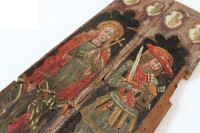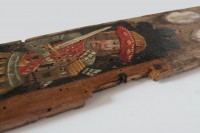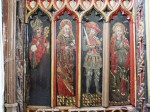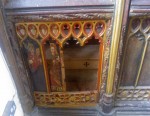 Two 15th century painted oak panels ripped out of Holy Trinity Church in Torbryan, Devon, almost two years ago have been recovered by police. A sharp-eyed and damn decent collector spotted them in an online sale and notified the authorities who traced them in a property in south London. The place was raided by detectives from the Metropolitan Police Art & Antiques Unit in January and the panels recovered. A 50-year-old man from Wales has been arrested for the theft.
Two 15th century painted oak panels ripped out of Holy Trinity Church in Torbryan, Devon, almost two years ago have been recovered by police. A sharp-eyed and damn decent collector spotted them in an online sale and notified the authorities who traced them in a property in south London. The place was raided by detectives from the Metropolitan Police Art & Antiques Unit in January and the panels recovered. A 50-year-old man from Wales has been arrested for the theft.
The panels were part of a rood screen, a tracery partition separating the nave from the chancel, built between 1460 and 1470. Inset in Gothic arches that mimic the design of the church’s stained glass windows are a series of 40 oak panels painted with figures of God, Mary, the Apostles and a panoply of saints. They are of extremely high quality, “cathedral quality,” according to the art historian Dr. Neil Rushton of the Churches Conservation Trust. Painted by a top artist of the period at the same time the church was constructed, the rood screen panels are colorful evidence of how much money, mainly from the wool trade, was in the area in the second half of the 15th century. They are the country’s best surviving examples of this kind of art from the late Middle Ages, almost all of which was destroyed in the Reformation, and therefore of national importance.
 The panels that were stolen depict St. Victor of Marseilles and St. Margaret of Antioch, lesser known saints which make them rarer than the panels with more common iconography. Because of their rarity, there was speculation at the time of the theft that it may have been commissioned by an underworld collector who coveted these specific pieces, but the commissioned theft idea always gets deployed after these sort of crimes and it usually turns out to be a lot more Keystone Cops and a lot less Thomas Crown. This case is no different. Commissioned thefts don’t wind up for sale online.
The panels that were stolen depict St. Victor of Marseilles and St. Margaret of Antioch, lesser known saints which make them rarer than the panels with more common iconography. Because of their rarity, there was speculation at the time of the theft that it may have been commissioned by an underworld collector who coveted these specific pieces, but the commissioned theft idea always gets deployed after these sort of crimes and it usually turns out to be a lot more Keystone Cops and a lot less Thomas Crown. This case is no different. Commissioned thefts don’t wind up for sale online.
 Churches have increasingly been frequent targets of thieves, often for the scrap value of their architectural materials like lead roof tiles or even paving stones and grave markers. Art is a riskier proposition since it’s more likely to be recognizable, but that hasn’t stopped thieves from taking the chance before at the Holy Trinity Church. Four of the original 40 panels were stolen in the 1990s and three more were taken in 2003. Those seven panels are still missing which makes the recovery of the two most recent thefts even more significant.
Churches have increasingly been frequent targets of thieves, often for the scrap value of their architectural materials like lead roof tiles or even paving stones and grave markers. Art is a riskier proposition since it’s more likely to be recognizable, but that hasn’t stopped thieves from taking the chance before at the Holy Trinity Church. Four of the original 40 panels were stolen in the 1990s and three more were taken in 2003. Those seven panels are still missing which makes the recovery of the two most recent thefts even more significant.
West Mercia Police are now leading the investigation into the theft as part of Operation Icarus, which has also recovered a treasure trove of other church artefacts, including stonework, friezes, statues, paintings, brasses, misericords, stained glass and bibles. The police are appealing for help in identifying the artefacts, which include the misericords from St Cuthbert’s Church at Holme Lacy in Herefordshire, also in the care of The Churches Conservation Trust.
In response to the original theft, The Churches Conservation Trust conducted a thorough audit of security at Holy Trinity, Torbryan and a new alarm system is now in place at the church to protect its contents in future. A new scheme of interpretation is also being developed to explain the artworks and the history of this unique Grade I listed church to visitors. A service at the church on 30th May will give thanks for the return of the panels.
 The 45 cm (17.7 inches) by 15 cm (6 inches) panels were stolen between August 2nd and 9th of 2013 when the church was open to the public. They are believed to have been pushed out of their casing from the front, but a panel of an unknown female saint to the immediately left of the stolen pieces was seriously damaged in the process. It was punched through and a large shard from the top of the panel to the saint’s legs broke off. Now that the missing panels have been recovered, it’s clear there was damage done to them as well during the theft. The restoration is expect to cost £7,000 ($10,843) and the Churches Conservation Trust has launched a campaign to raise the funds.
The 45 cm (17.7 inches) by 15 cm (6 inches) panels were stolen between August 2nd and 9th of 2013 when the church was open to the public. They are believed to have been pushed out of their casing from the front, but a panel of an unknown female saint to the immediately left of the stolen pieces was seriously damaged in the process. It was punched through and a large shard from the top of the panel to the saint’s legs broke off. Now that the missing panels have been recovered, it’s clear there was damage done to them as well during the theft. The restoration is expect to cost £7,000 ($10,843) and the Churches Conservation Trust has launched a campaign to raise the funds.
 Click here to donate online. Your title (I recommend His Tremendousness), name, email and street address are required fields. You have to type in the amount you wish to donate and check the boxes to opt out of them spamming you via email, post or phone. The last field asks you to confirm or deny whether you’re an UK taxpayer and then when you click donate you’ll be taken to a secure credit card donation form. The amount is already fixed so if you change your mind about how much you want to give you have to go back to the previous page.
Click here to donate online. Your title (I recommend His Tremendousness), name, email and street address are required fields. You have to type in the amount you wish to donate and check the boxes to opt out of them spamming you via email, post or phone. The last field asks you to confirm or deny whether you’re an UK taxpayer and then when you click donate you’ll be taken to a secure credit card donation form. The amount is already fixed so if you change your mind about how much you want to give you have to go back to the previous page.
You can also donate by calling 0800 206 1463 or you can quickly donate £20 by texting TORB15 £20 to 70070.
nice post with great content.. I am huge fan of your site
Even if we acknowledge that churches are targets because of their architectural materials (eg lead roof tiles, paving stones and grave markers), art is different. Art is not used as architectural material in newer buildings and it has no scrap value. An unlike the Puritans who had a religious motive for pulling down “papal” paintings, sculpture and stained glass, these thieves are out exclusively to line their own pockets.
I think thieves of medieval art should be put in stocks in the middle of town and let people throw rotten vegetables at them gggggrrrr.
The web site for donations does not accept PayPal (which allows for US$ to British pound conversions). Apparently it also does not accept credit cards issued in the US, probably because the donation amounts are in pounds and this is not the currency employed in US credit card transactions.
Bummer!
Psalm 22, 6: ‘FOR Y AM A WOODWORM, AND NOT MAN; THE SCHENSCHIP OF MEN, AND OUTCASTYNG OF THE PUPLE’ – Without reasonable doubt, the culprit will be born again – Therefore, repent he must ! – https://www.youtube.com/v/ffd5zv2R-ag
Hels:
Agreed, era of subject of theft should match era of punishment, or thereabouts. That would go a long way to discouraging this sort of thing, I’m sure. And would probably give the judges a good giggle to hand down some punishments long since abandoned (personal favorite: time on the treadmill, which, according the “Forgotten English” calendar, was originally developed as a means to demoralize and pacify prisoners).
Still, we’d have to find a way to protect the pilloried from people with selfie sticks. Even the consummate artist of medieval torture would find that excessive. 😉
Afton Ruark Â